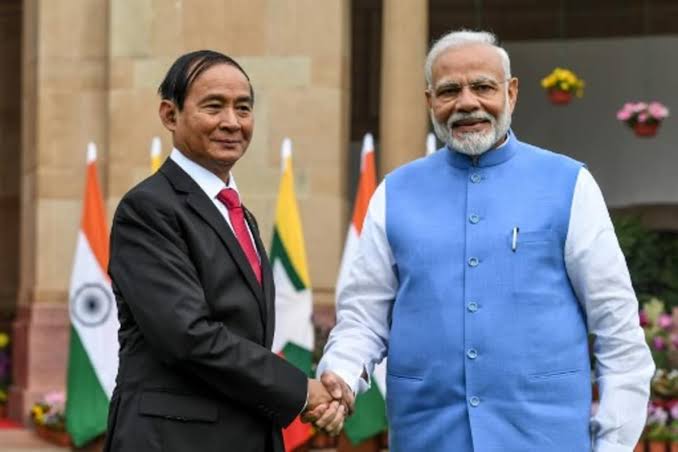Japan, India Step Up Engagement With Myanmar To Counter Rising China

Myanmar falls not just in its ‘Neighbourhood First’ strategy but also in its ‘Act East’ policy, while Japan funds development projects and brokers peace with India’s neighbour
Japan is stepping up its engagement with Myanmar, with Watanabe Hideo, chairman of the Japan-Myanmar Association (JMA) and a former member of the House of Councillors of Japan being the latest visitor to arrive at Naypyidaw.
The Irrawaddy newspaper reported that Watanabe met Myanmar State Counsellor Aung San Suu Kyi, Defence chief General Min Aung Hlaing and senior officials on his two-day visit earlier this week.
Discussions included Japanese investment as well as improving defence relations. Naypyidaw is keen to expand Japanese aid for socio-economic development, particularly in the education and health sectors.
Japan is increasing efforts to pull Myanmar away from Chinese clutches. It is supporting Suu Kyi’s party, the National League for Democracy (NLD), in an effort to develop democracy in the country. Japan has tried to ensure that some of the warring communities in the ethnically diverse country were not disenfranchised during the recently held elections. It is also negotiating peace between the Myanmar Army, called the Tatmadaw, and the Arakan Army (AA) insurgents.
Japan is well poised to discuss Myanmar’s internal issues with its top leadership as the country enjoys trust of both the main actors in Myanmar – the still powerful army as well as the new political dispensation. Watanabe himself has been in regular touch with the military regime through his frequent travels to Myanmar even before democracy was restored by the generals.
Visitors from Japan are not rare in Naypyidaw. In December 2020, Yohei Sasakawa, special envoy of the government of Japan for national reconciliation in Myanmar, and the chairman of the Nippon Foundation visited the country twice in quick succession. Sasakawa met both Suu Kyi and General Min Hlaing. He was the one who had successfully brokered a ceasefire between the AA and the Myanmar Army to ensure that elections went off smoothly and all people had equal representation. For the first time in two years the AA and the Myanmar military saw a ceasefire since fighting broke out in 2018.
Japan recently agreed to a Myanmarese proposal to develop its troubled Dawei Special Economic Zone (SEZ). Once fully developed, the 200-km region would be South-East Asia’s largest industrial complex. The Dawei SEZ ran into trouble as the Thai company developing it pulled out of the project in 2013. Soon after this, Myanmar requested Japan to fund the strategically located SEZ.
The $8 billion Dawei SEZ project is on the Andaman Sea and connects the Gulf of Thailand by road. It links the Indian Ocean to the Pacific Ocean and also joins South Asia to South-East Asia. Japan’s involvement here could mean a spur to its own vision of creating the Japan Mekong Southern Economic Corridor, which aims to connect Vietnam, Cambodia and Thailand to southern Myanmar.
Japanese Ambassador to Myanmar Ichiro Maruyama told The Irrawaddy in an exclusive interview in November 2020 that Japan has decided to invest in the project, both for developing the deep-sea port as well as the SEZ. Meanwhile, numerous Chinese firms have shown interest in the project but Myanmar remains lukewarm to those proposals. Besides the Dawei SEZ, where Japan has shown interest, it is developing the Thilawa SEZ also.
Talking about Myanmar-Japan relations, India’s premier think tank, the Observer Foundation said: “While Chinese presence has been domineering, the presence of Japan has the potential for surpassing the former.” The article adds that Japan had been supporting the military government with humanitarian assistance in return for bringing out positive changes. That connect continues with Suu Kyi’s democratically elected government.
Japan is making sustained efforts to keep Myanmar out of China’s reach with a holistic strategy. Quoting the Myanmarese government, The Irrawaddy says that “Japan invested more than $60 million in 2016-2017, $384 million in 2017-2018, $176 million in 2018-2019 and $768 million in 2019-2020”.
Japan is infusing money into Myanmar through various projects. Japan International Cooperation Agency (JICA) too is putting in aid in almost every field from education to tourism.
India is working on a similar strategy. Through its multi-pronged approach, New Delhi and Naypyidaw have developed a trustworthy bond in a short time. On Thursday, Myanmar became one of the first group of friendly neighbours to have received the COVID-19 vaccines from India, within days of New Delhi launching its own mass vaccination program.
India’s reach out covers humanitarian development, defence procurement and joint military exercises. The Myanmar Navy is operating its first submarine, courtesy India. It is jointly patrolling the border with Indian forces to ensure that militant activities are curbed. More and more Myanmar’s defence personnel are undergoing training in India. The Indian army chief as well as the navy chief made separate visits to Myanmar in 2020 while General Min Hlaing had visited India mid-2019.
The two countries are also working on a number of development projects, with the Kaladan project getting a contribution of $484 million from India. Through this project India not only seeks to boost connectivity to its North-East but also plans to ensure that the local people in Myanmar are benefited through jobs and better infrastructure.
As Myanmar opens up to the outside world through its fledgling democracy, countries like India and Japan are reciprocating in equal measure. For India, Myanmar falls not just in its ‘Neighbourhood First’ strategy but also in its ‘Act East’ policy, while Japan funds development projects and brokers peace with India’s neighbour.




